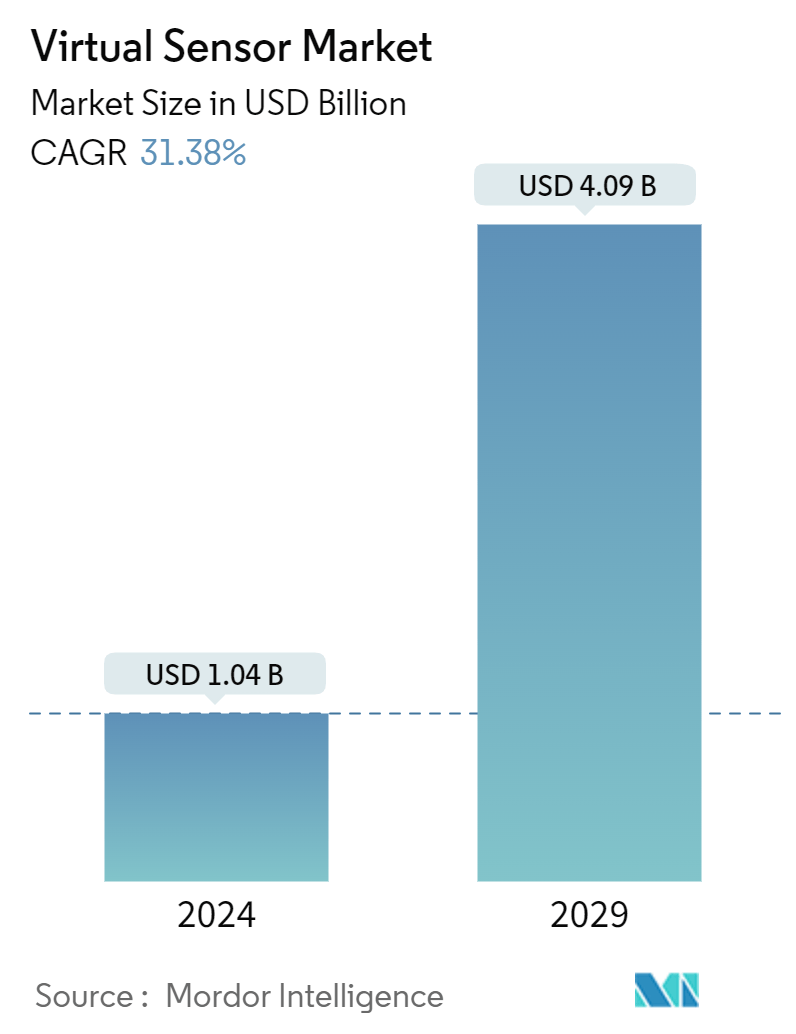Market Size of Virtual Sensor Industry

| Study Period | 2019 - 2029 |
| Market Size (2024) | USD 1.04 Billion |
| Market Size (2029) | USD 4.09 Billion |
| CAGR (2024 - 2029) | 31.38 % |
| Fastest Growing Market | Asia Pacific |
| Largest Market | Asia Pacific |
| Market Concentration | Low |
Major Players
*Disclaimer: Major Players sorted in no particular order |
Virtual Sensors Market Analysis
The Virtual Sensor Market size is estimated at USD 1.04 billion in 2024, and is expected to reach USD 4.09 billion by 2029, growing at a CAGR of 31.38% during the forecast period (2024-2029).
The virtual sensors market has the potential to expand significantly and become a key component in numerous future applications related to physical sensors. The growing adoption of these sensors is primarily driven by the benefits they offer to various industries.
- Virtual sensors, also known as soft sensors, are software-based solutions developed using a mathematical model of multiple output readings from physical sensors. The limitations of physical sensors can be overcome by deploying these virtual sensors. A single virtual sensor can predict various parameters such as speed, temperature, position, and pressure.
- As a result, they offer cost benefits and find applications in industries such as IoT, Cloud, security, analytics, process industry, oil & Gas, transportation, automotive, consumer electronics, healthcare, and defense & aerospace. Advancements in the sensor and control industry will drive the growth of the virtual sensor market.
- Leading manufacturers are adopting a cloud-based virtual sensing solution as a standard platform. Implementing virtual sensors on a cloud platform offers several benefits, such as enhancing data connectivity between users and the sensor-cloud server.
- Moreover, these solutions facilitate efficient transportation monitoring, accurate weather forecasting, improved military activities, and enhanced healthcare services. The cloud platform also enables end-users to reduce overall ownership costs and expand data storage capabilities, consequently contributing to the growth of the virtual sensor market.
- The increasing demand for cost-efficient solutions and improved operational efficiency in the manufacturing sector fuels the adoption of cutting-edge technologies in the industry. To keep their competitive edge and reduce production costs, manufacturing companies of all sizes constantly focus on discovering and applying new tactics. If they optimize their cost structures, they can avoid losing a sizable portion of the market to competitors who can operate more profitably or, worse still, become obsolete. Businesses constantly seek creative ways to cut expenses without sacrificing productivity or efficiency.
- Furthermore, due to increased digital transformation, cloud computing demand has skyrocketed across organizations. The cloud offers extensive benefits over the on-premise deployment, which fuels the adoption of cloud services. The prevalence of new small-scale companies and startups based on the cloud from their inception influences the demand for cloud computing skills.
Virtual Sensors Industry Segmentation
The sale of virtual sensors in different end-user industries such as manufacturing, oil and gas, transportation and automotive, metal and mining, aerospace and defense, electronics and semiconductor, and other industries across various regions determines the market. Additionally, the analysis monitors the crucial market parameters, fundamental factors that affect growth, and significant industry players to support the evaluation of market size and growth rates during the projected period.
The virtual sensors market is categorized according to deployment type (either cloud-based or on-premise), the industry of the end user (including sectors like oil & gas, manufacturing, transportation and automotive, metals and mining, aerospace and defense, electronics and consumer technologies, among others), and geographic location (covering North America [with specifics on the United States and Canada], Europe [highlighting the United Kingdom, Germany, France, Italy, and the rest of Europe], Asia-Pacific [featuring China, Japan, India, and the rest of Asia-Pacific], and the Rest of the World). This report presents forecasts and the market size in terms of value (USD) for all these segments.
| By Deployment Type | |
| Cloud | |
| On-premise |
| By End-user Industry | |
| Oil and Gas | |
| Manufacturing | |
| Transportation and Automotive | |
| Metal and Mining | |
| Aerospace and Defense | |
| Electronics and Consumer Technologies | |
| Other End User Industries |
| By Geography*** | ||||||
| ||||||
| ||||||
| ||||||
| Australia and New Zealand | ||||||
| Latin America | ||||||
| Middle East and Africa |
Virtual Sensor Market Size Summary
The virtual sensors market is poised for substantial growth, driven by their increasing adoption across various industries. These software-based solutions, also known as soft sensors, leverage mathematical models to predict multiple parameters, overcoming the limitations of physical sensors. This capability offers significant cost benefits and finds applications in sectors such as IoT, cloud computing, security, analytics, and more. The shift towards cloud-based virtual sensing solutions is particularly notable, as it enhances data connectivity and reduces ownership costs. The demand for cost-efficient and operationally efficient solutions in manufacturing further propels the adoption of virtual sensors, as companies strive to maintain competitiveness and optimize cost structures.
In the automotive industry, virtual sensors are becoming integral due to their diverse applications, including advanced driver assistance systems (ADAS) and autonomous vehicle technologies. Despite the high costs and occasional unreliability of physical sensors, virtual sensors provide a cost-effective alternative, enhancing safety and efficiency. The growing trend of digital twin technology in transportation and the increasing demand for cloud computing skills, particularly in regions like China and Japan, also contribute to market expansion. Additionally, the aerospace and defense sectors are leveraging virtual sensors for improved navigation and predictive maintenance. The market is characterized by a mix of large international firms and smaller businesses, with key players engaging in strategic partnerships and acquisitions to strengthen their market position.
Virtual Sensor Market Size - Table of Contents
-
1. MARKET DYNAMICS
-
1.1 Market Drivers
-
1.1.1 Increasing Adoption of IoT and Cloud Platform Is Expected to Drive the Market
-
1.1.2 Growing Need For Enhanced Cost-effectiveness and Operational Efficiency in Manufacturing
-
-
1.2 Market Challenges
-
1.2.1 Lack of Skilled Manpower and Technical Knowledge
-
1.2.2 Data Security and Privacy Concerns
-
-
-
2. MARKET SEGMENTATION
-
2.1 By Deployment Type
-
2.1.1 Cloud
-
2.1.2 On-premise
-
-
2.2 By End-user Industry
-
2.2.1 Oil and Gas
-
2.2.2 Manufacturing
-
2.2.3 Transportation and Automotive
-
2.2.4 Metal and Mining
-
2.2.5 Aerospace and Defense
-
2.2.6 Electronics and Consumer Technologies
-
2.2.7 Other End User Industries
-
-
2.3 By Geography***
-
2.3.1 North America
-
2.3.1.1 United States
-
2.3.1.2 Canada
-
-
2.3.2 Europe
-
2.3.2.1 United Kingdom
-
2.3.2.2 Germany
-
2.3.2.3 France
-
2.3.2.4 Italy
-
-
2.3.3 Asia
-
2.3.3.1 China
-
2.3.3.2 Japan
-
2.3.3.3 India
-
-
2.3.4 Australia and New Zealand
-
2.3.5 Latin America
-
2.3.6 Middle East and Africa
-
-
Virtual Sensor Market Size FAQs
How big is the Virtual Sensor Market?
The Virtual Sensor Market size is expected to reach USD 1.04 billion in 2024 and grow at a CAGR of 31.38% to reach USD 4.09 billion by 2029.
What is the current Virtual Sensor Market size?
In 2024, the Virtual Sensor Market size is expected to reach USD 1.04 billion.

